The Magic Brush of Dreams Chapter Notes | Chapter Notes For Class 8 PDF Download
| Table of contents |

|
| Introduction |

|
| About the Poet |

|
| Key Points of the Poem |

|
| Explanation of the Poem |

|
| Theme/Message |

|
| Difficult Words |

|
Introduction
Can a simple brush create magic?
In “The Magic Brush” (adapted from a folk tale), we meet Gopi, a young girl with a kind heart and a big imagination. One day, while drawing pictures in the sand, she is gifted a special paintbrush, but with one condition: she must use it only to help the poor. What follows is a thrilling story of bravery, kindness, and the triumph of good over greed. Through Gopi’s journey, the poem shows how imagination and goodness can change the world.
About the Poet
The poem is adapted from a folk tale and does not have a specific poet credited. Folk tales are stories passed down through generations, often containing lessons, morals or cultural values. This particular tale celebrates creativity, kindness, and the importance of helping others. The characters in folk tales are usually simple and relatable, allowing readers to connect with them easily. In this poem, we see the character Gopi, a young girl who possesses a magical brush that can bring her paintings to life. The story highlights the themes of generosity, the power of art, and the conflict between wealth and compassion. Folk tales like this one often teach us important lessons while entertaining us with imaginative scenarios and characters.
Key Points of the Poem
- The poem tells the story of a girl named Gopi who has a magical brush.
- Gopi is tasked with gathering food but is more interested in painting.
- A mysterious man gives her a brush that can create real objects.
- Gopi decides to use her magic for good, helping the poor villagers.
- The Zamindar, a wealthy landowner, demands that Gopi paint for him.
- Gopi refuses to paint for the rich, choosing to help the needy instead.
- She is imprisoned by the Zamindar for her refusal.
- Gopi cleverly escapes using her magic brush to paint a road and a horse.
- She outsmarts the Zamindar and his men, leading them on a wild chase.
- In the end, Gopi paints a feast for the villagers, celebrating their victory.
- The poem teaches valuable lessons about kindness and using one's talents for good.
Explanation of the Poem
Stanza 1
“Go and gather wild beans, Gopi,
Go and fetch some rice.
Go and pluck the mangoes
And bring home something nice.”
Explanation:
At the beginning of the poem, Gopi’s family gives her some tasks. She is asked to go out and collect wild beans, rice, and mangoes—some basic food items from the village or forest. The family wants her to bring back something good to eat. This shows that Gopi belongs to a simple, rural household where people gather food from nature.
Stanza 2
Gopi sits beneath the banyan,
A twig is in her hand.
She sits there drawing pictures,
Pictures in the sand.
Explanation:
Instead of doing the work she was given, Gopi sits under a big banyan tree. She holds a small twig (like a thin stick) in her hand and begins drawing pictures in the sand. This shows her love for creativity and imagination. Even though she was sent to bring food, her mind is full of dreams and drawings.
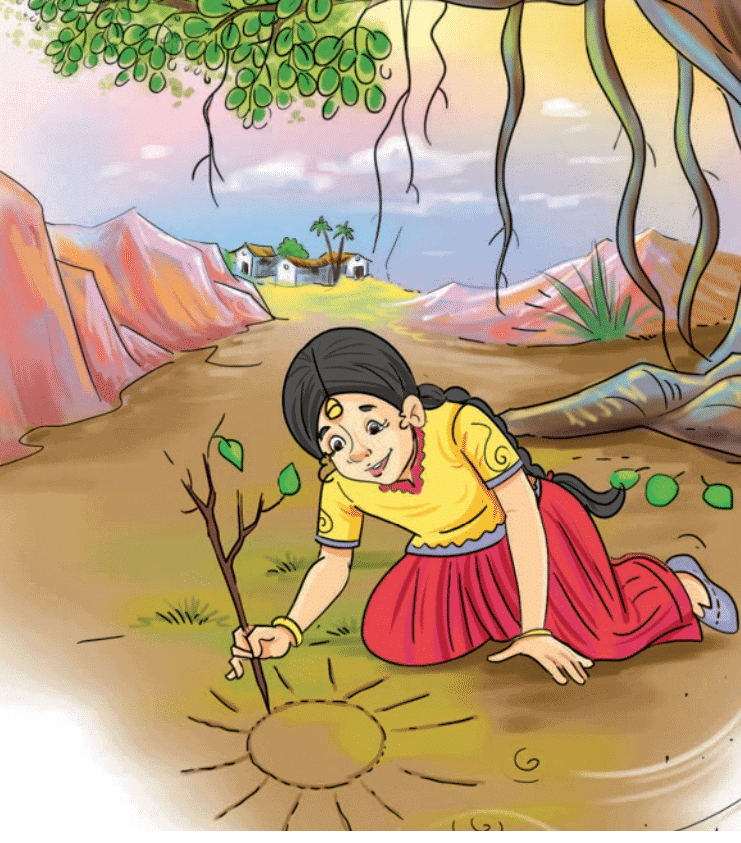
Stanza 3
The winds blow by and sweep away
The pictures in the sand.
But on a stone there sits a man,
A brush is in his hand.
Explanation:
The wind comes and wipes away Gopi’s drawings, but something magical happens. A mysterious man is sitting nearby on a stone. He holds a brush in his hand. This moment shows that something unusual or magical is about to happen in Gopi’s life.
Stanza 4
He looks around. He calls to Gopi.
“Come here!” he whispers. “Hush!
We mustn’t let the village know
About this magic brush.”
Explanation:
The man quietly calls Gopi over. He speaks in a whisper, telling her not to tell anyone else about the brush. He calls it a magic brush, which makes us wonder what powers it has. The secrecy shows that it is something very special and powerful, not for everyone to use.
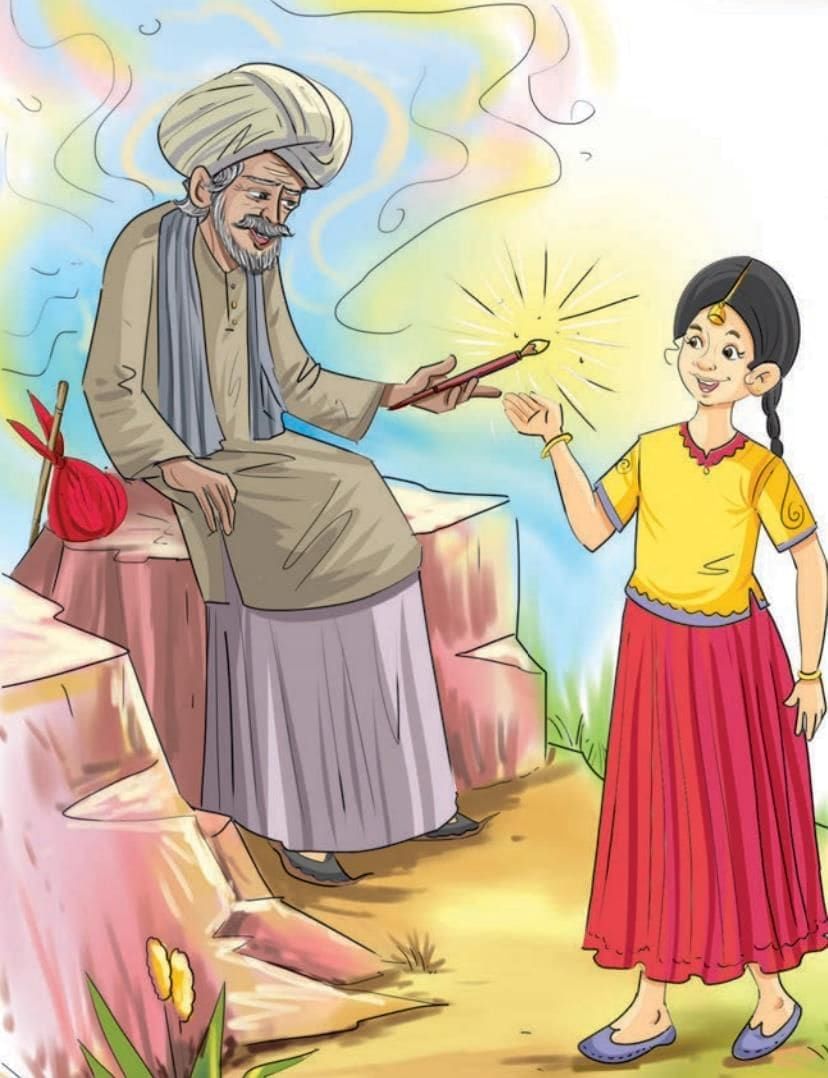
Stanza 5
He slips the brush into her hand
And tells her to be sure,
“Paint not for the wealthy ones,
But only for the poor.”
Explanation:
The man hands the brush to Gopi and gives her a strong rule—she must never use it to help rich people (the wealthy), only the poor and needy. This shows that the brush is meant to bring justice and kindness, not to make greedy people richer.
Stanza 6
“Did you gather wild beans, Gopi?
Did you fetch some rice?
Did you pluck the mangoes
And bring home something nice?”
Explanation:
Gopi’s family or someone from the house asks if she collected the food they sent her for. They expect her to return with real things like beans, rice, or mangoes. They don’t know anything about the magic brush yet.
Stanza 7
“No beans, no rice, no mangoes!”
Gopi grins and runs inside.
She paints a bowl of khichdi
and waits,
Until the paint has dried
Explanation:
Gopi smiles mischievously and runs inside. She hasn’t brought any real food, but she uses her new magic brush to paint a bowl of khichdi (a rice and lentil dish). She waits for the paint to dry, showing that she trusts the brush’s powers. This is the first time we see how the brush works.
Stanza 8
“The bowl is full of khichdi, Gopi!”
Into the house the villagers streamed
The young and old all wish to see
The magic brush of dreams.
Explanation:
Amazingly, the painting turns into a real bowl of khichdi! The news spreads quickly, and many villagers come to Gopi’s house to see this “magic brush of dreams.” People of all ages are curious and amazed by what she can do. Gopi is now seen as someone special in the village.
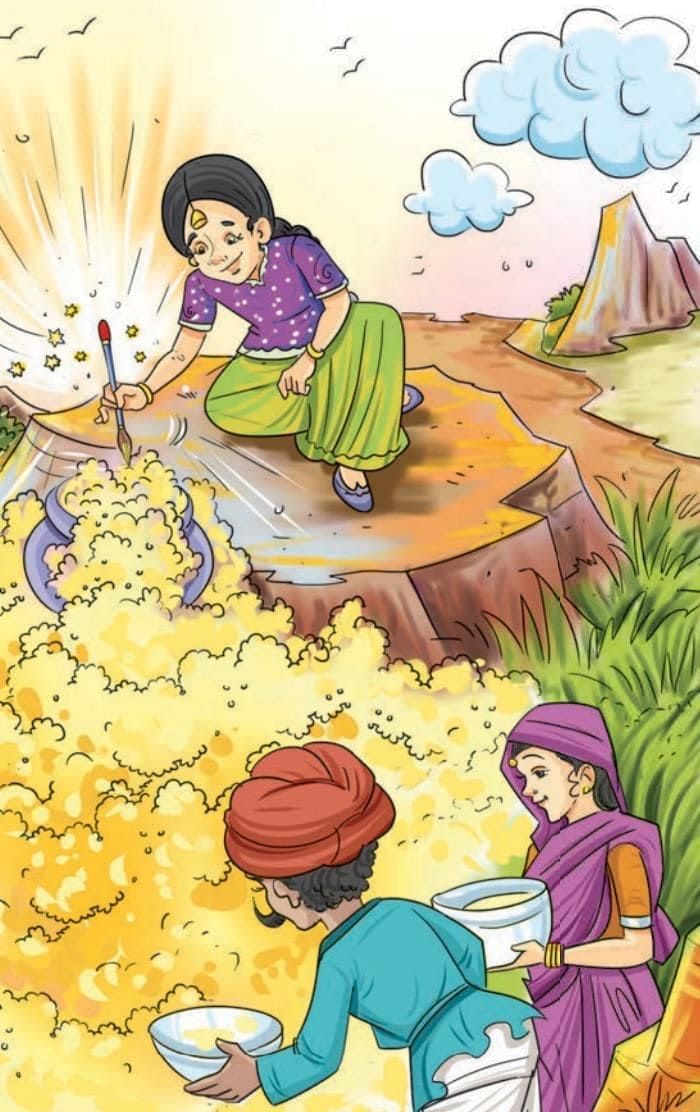
Stanza 9
She paints a muffler for a farmer,
A plough for another man,
A shawl for a grandmother,
And for a girl, a fan.
Explanation:
Gopi uses the magic brush to help people in the village. She paints useful things like a muffler (scarf) to keep a farmer warm, a plough to help with farming, a shawl for a grandmother to stay cozy, and a fan to keep a girl cool. All these things become real, proving Gopi is generous and thoughtful.
Stanza 10
And soon the news spreads far and wide,
Through forests, fields, and plains,
Until the Zamindar himself
Hears of these magic gains.
Explanation:
As Gopi continues helping people, the story spreads to places far away. Eventually, the Zamindar (a rich landlord or ruler) hears about the magic brush. The poem now hints at a coming conflict between Gopi and someone greedy.
Stanza 11
“I order you to paint for me,
A fortress tall and grand.
Paint treasures, jewels, and riches rare,
Enough to rule this land.”
Explanation:
The Zamindar commands Gopi to paint a huge palace (fortress) and lots of jewels and riches so he can become more powerful. He only thinks about wealth and power—not about helping others.
Stanza 12
Gopi bows and shakes her head.
“My lord, I can’t comply.
I swore to use this magic brush
To help the needy by.”
Explanation:
Gopi politely refuses. She says she made a promise to only help the poor. The word “comply” means to agree or obey. Gopi is brave and sticks to her values, even when speaking to a powerful man.
Stanza 13
The Zamindar roars and stamps his foot.
He bellows to his men,
“Seize this brush and seize the girl.
Throw her in the pen!”
Explanation:
The Zamindar becomes very angry and shouts loudly (bellows). He tells his guards to take both Gopi and the brush and put her in the pen—a small, closed prison. He wants to take control by force.
Stanza 14
Now Gopi waits inside the cell,
Upon a cold mud floor.
Until the Zamindar returns
And shouts through the door.
Explanation:
Gopi is now locked in a dark and uncomfortable prison. She sits on the cold mud floor, waiting. This scene shows her difficult situation and builds suspense about what will happen next.
Stanza 15
He holds the brush. He thunders loud,
“Paint my fortress tall!
Paint gold and rubies, emeralds bright,
And you shall leave this hall!”
Explanation:
The Zamindar offers Gopi freedom—but only if she paints treasures for him. He talks about rubies and emeralds (precious stones) and a fortress, which again shows his greed.
Stanza 16
That night the Zamindar lies in bed,
Dreaming of his gold,
While Gopi paints a winding road,
A horse both strong and bold.
Explanation:
While the Zamindar sleeps, dreaming of riches, Gopi uses the brush cleverly. She paints a winding road and a strong horse—tools to help her escape from prison.
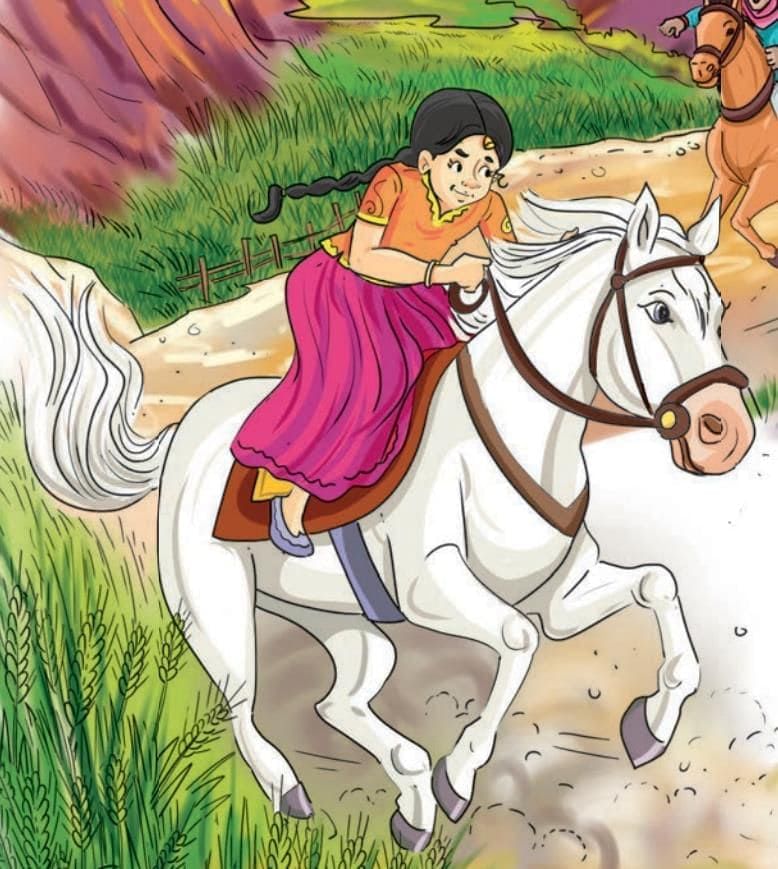
Stanza 17
The road leads out of prison gates.
The horse, she swiftly urges
Gopi leaps on and gallops fast,
Through fields and many villages.
Explanation:
The magic painting comes to life. The road opens the way out of the prison, and the horse lets Gopi escape. She rides through the countryside quickly, showing her courage and cleverness.
Stanza 18
“It’s Gopi! It’s Gopi! She’s back again!”
Say the villagers, merry and kind.
But Gopi keeps on painting still,
With the Zamindar’s men following behind.
Explanation:
The villagers are happy to see Gopi again, but she doesn’t stop—she keeps painting, as the Zamindar’s men are chasing her. The tension rises again as the story is not over yet.
Stanza 19
She paints a mighty river wide,
Its currents fast and deep.
The Zamindar and all his men
Stop short and cannot leap.
Explanation:
To block her pursuers, Gopi paints a wide, fast-flowing river. It becomes real, and the Zamindar’s men can’t cross it. This shows how she uses her wit to protect herself.
Stanza 20
“Now should I paint a beast
To leap and chase you through?
Stop this chase or it will feast
On you, and you and you!”
Explanation:
Gopi warns the Zamindar’s men that she could paint a dangerous beast to attack them. Her warning is powerful and scary. She shows that she can defend herself without hurting anyone—unless she’s forced to.
Stanza 21
The Zamindar cries, “No, no, no more!
I’ll leave, I’ll go away!”
He turns and flees; his men behind
Dare not choose to stay.
Explanation:
The Zamindar becomes scared and runs away, shouting that he gives up. His men follow him because they are too afraid to stay behind. Gopi has won without using violence—just her cleverness and courage.
Stanza 22
Now Gopi paints for the village folk,
A feast of sweets and tea.
A courtyard bright, a band to play,
And songs of victory.
Explanation:
Back in the village, Gopi paints a big celebration for everyone. She paints sweets, tea, music, and joyful things. Everyone celebrates her return and her victory. The ending is happy and festive.
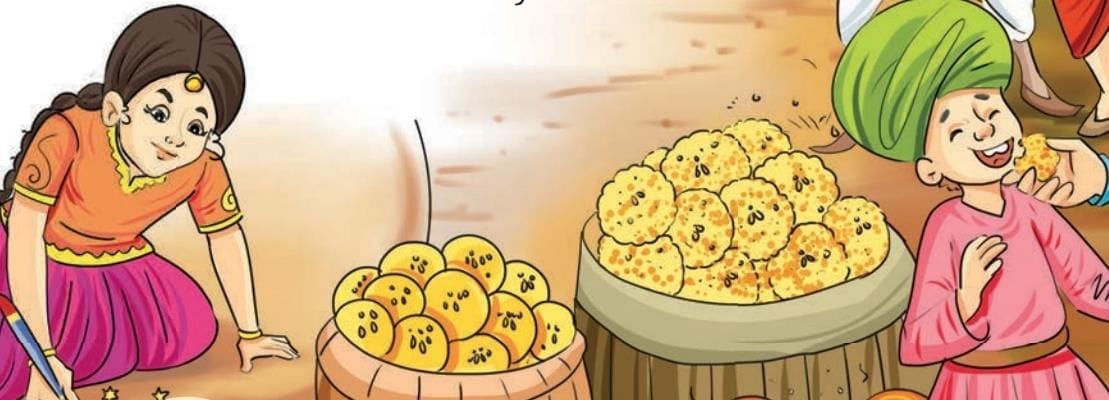
Theme/Message
Theme
- The Power of Art: The poem emphasises how art can be magical and transformative. Gopi's paintings come to life, showing that creativity can change the world around us.
- Helping Others: Gopi chooses to use her magic brush to help the poor villagers instead of painting for the wealthy. This highlights the importance of generosity and community.
- Bravery and Resistance: Gopi shows bravery by standing up to the Zamindar. She refuses to give in to pressure and remains committed to her promise to help those in need.
- Wealth vs. Kindness: The conflict between Gopi and the Zamindar illustrates the struggle between the rich and the poor, and how true value lies in kindness rather than wealth.
Message
- Use Your Talents Wisely: The poem encourages readers to use their skills for good. Gopi's magic brush symbolises the power of creativity to bring joy and help others.
- Stand Up for What is Right: Gopi's refusal to paint for the wealthy teaches us the importance of standing up for our beliefs, even in difficult situations.
- Community Matters: The joy and celebration of the villagers show that we are stronger together. Helping one another leads to happiness and unity.
- True Happiness Comes from Giving: The ending of the poem, where Gopi paints a feast for the villagers, reinforces that true happiness comes from sharing and caring for others.
Difficult Words
- Zamindar: A landowner or landlord, often with power over the village.
- Muffler: A piece of clothing worn around the neck for warmth.
- Plough: A tool used in farming to turn over soil for planting.
- Emerald: A precious green gemstone.
- Fortress: A large fortified building or military stronghold.
- Currents: The flow of water in a river or stream.
- Feast: A large meal, usually celebrating a special occasion.
- Chase: To run after someone or something.
- Grand: Magnificent or impressive in appearance or style.
- Whispers: To speak very softly.
- Grins: To smile broadly.
- Hush: To make someone be quiet.
- Gains: Acquisitions or benefits, often referring to wealth.
FAQs on The Magic Brush of Dreams Chapter Notes - Chapter Notes For Class 8
| 1. What is the main theme of "The Magic Brush of Dreams"? |  |
| 2. Who is the poet of "The Magic Brush of Dreams" and what is their significance? |  |
| 3. What are some difficult words in "The Magic Brush of Dreams" and their meanings? |  |
| 4. How does the poet use imagery in "The Magic Brush of Dreams"? |  |
| 5. What message does "The Magic Brush of Dreams" convey to its readers? |  |















